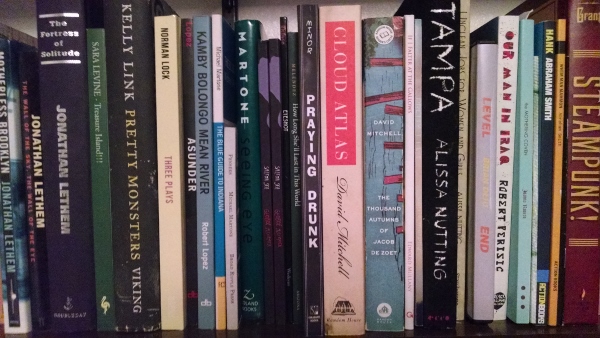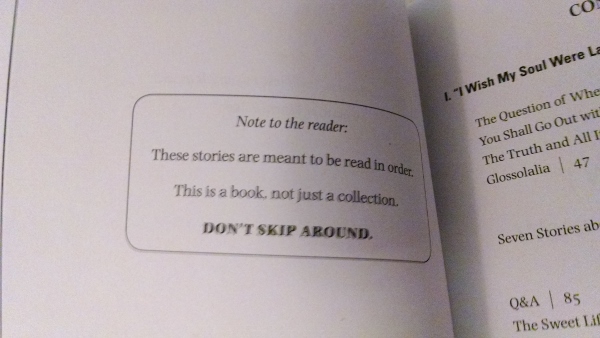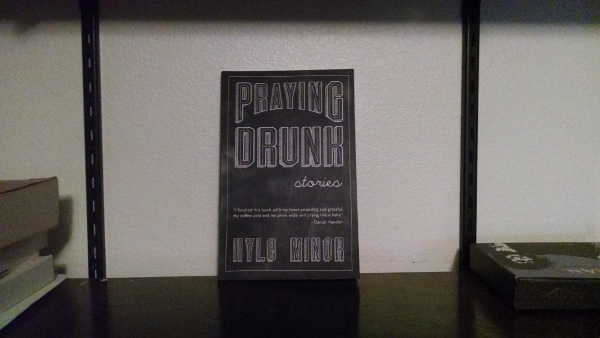I Like __ A Lot
Thoughts on Kyle Minor’s Praying Drunk
I read Kyle Minor’s Praying Drunk over the past several weeks. I would have liked to read it more quickly, perhaps ideally over the course of four days, but things kept getting in the way. There were appointments with repairmen. There was work. There was a trip back home to Indiana. I had a reading. My family attended. My brother is currently taking a creative writing course with Kyle Minor. That same day, I read the second half of “In a Distant Country,” the longest story in the book. I almost cried. I told my brother that his writing instructor was good. “Do whatever he tells you to do,” I said. I told my brother how I almost cried. “That’s really good,” said my brother.
I said, “It is!” It’s very good.
Here is a picture of Praying Drunk on my bookshelf:

When you open the book there are the usual materials. There are title pages, there is a copyright page, there is the dedication. There is an epigraph. And then there is this:

My hands shake constantly, and more as I get older, so that photo is a little blurry. It reads, “Note to the reader: These stories are meant to be read in order. This is a book, not just a collection. DON’T SKIP AROUND.”
I knew that this page would be here because the review and the interview I’d skimmed while I waited for the book to come both mentioned it early. I was a little surprised by the combination of bold and caps in that last sentence. And honestly I resented it; though the sting is out now, I still do. I resent anything that I perceive as interference in my interaction with a fiction. This is why I only skimmed those reviews and interviews. I didn’t want them in my head when I was enjoying the book.
I don’t like this page because I feel that it inelegantly attempts to coerce behaviors that I think a smart designer could encourage by subtler methods. For example, what if each story in the book had a number, like chapters in a novel? There are already numbered and titled sections, and within these sections there are nameless subsections set apart by empty black pages. These are good, quiet ways of guiding a reader through a collection. They give structure to the book and imply there is a correct order without insisting on that order. If Minor had asked me, I would have said these things were enough. I might have also asked if there is strong evidence that readers frequently skip around in single-author collections. (Probably they do, but I can’t imagine reading one that way myself. I’ve always assumed that any good collection was a book, was sequenced intentionally.)
But I understand why Minor chose to include the page above, or if it was his editor’s idea, consented. (I could ask him which of these it was, as we’ve already corresponded about the book a little, but for now, I don’t want to ask him, for the reasons I mentioned above. I am still thinking it through for myself.) In ways that don’t immediately make themselves clear, this is a tremendously risky book. It’s understandable that it might be a little overcautious in this one small regard.
Here is one way that the book is risky: It has one science fiction story. To have two or three science fiction stories would be reasonable and prudent, but having only one is a crazy thing to do. The story is well-situated in the book, and its structure is such that the really science-fictiony stuff doesn’t take center stage until you’ve already committed to the reality of the characters and their situation, but still, it bears repeating, there is just one science fiction story in this collection of stories that might otherwise be fairly described as literary realist fiction. It may be the weirdest decision I’ve ever seen in a short fiction collection. It’s the kind of risk I love to see. It’s also an excellent story, ruthless and full of sharp sentences.
Here is another risky thing this book does: it names the protagonist/narrator in one of its stories Kyle Minor. This character’s name is revealed only after you’ve already invested yourself in the story’s fictional reality, but also probably after you’ve started wondering whether maybe the author has experienced some of the things he’s writing about. Seeing that the character is named after the author, we might conclude that the story is indeed strictly autobiographical; and yet, Minor is clearly playing with our sense of the story’s reality and unreality, so we might reasonably wonder at this moment if in fact he has nothing in common with the character in the story. Maybe it’s all just a metafictional put-on, a strategy, a bit of fun.
This story puts others in the collection at risk as well, because there are other protagonist/narrators in Praying Drunk whom we might also be tempted to identify with the entity called Kyle Minor, even in perfect ignorance of his past and person. There are two pieces called “Q&A” in the book. The middle one is clearly the book’s author speaking directly to the reader, except for when it isn’t. Readers may be tempted to suppose that all the narrators in this book are really the author speaking directly to them. I don’t imagine that they are. (I don’t care either way, really.) But I do admire Minor’s willingness to risk this reading for the advantages of the heightened, dizzying state of unreality his book achieves by way of the strategy. It’s a sneaky way to reach the reader’s empathy. It won’t work for everyone, but it worked for me.
These stories are also linked by certain events (traumas, heartbreaks, and weird scenes) that echo throughout the book. This is why Minor wants us to read it in a certain order: the sequence in which we see these events may determine their cumulative effect. Certainly it is designed to do so.
For my part, I don’t think it’s really about the order, although I do think the insistence that there is a correct sequence will enhance for most readers the sense that there is something powerful at work in the book between its stories. And even if I sometimes disagreed with the book’s choices, I found it deeply satisfying to argue with Praying Drunk as I read it, because it argues well, and because it expanded my idea of what a collection can be and do. This in spite of the fact that it says it’s not a collection.
There are also the facts of the sentences and the characters, and the way that the stories are told, which I haven’t left myself time to discuss, but which are the things that made me come so close to crying.
Here is another picture of Praying Drunk on my bookshelf:

Tags: Kyle Minor, Praying Drunk

I totally agree about the reading instructions. I think it’s clunky and obnoxious–a blemish to an otherwise fine collection. I’ve ignored it and I still feel like I can enjoy the collection.
Even journals worth their weight should benefit from a cover-to-cover read. We’ve always taken for granted that the reader who skips around does so in the knowledge that they are at least taking a degree of the editorial intent into their own hands. Foregoing a table of contents can be an effective aid, also.
I agree! Uncanny Valley had tables of contents when it was still happening as a magazine, but they were nearly impossible to use by design. We also kept our issues short and manageable to facilitate reading in order. More magazines need to do that; I *try* to read the ones I buy straight through, but most of them have too much stuff in them for me to feel it’s worth wading through what I don’t especially enjoy. Of course, any mag with an editorial committee generally lacks in real vision/intent anyway, sadly.
I think that’s the right approach. To some extent it serves as a reminder to me that I should probably ignore the things I don’t like about books more often; I have that power as a reader, after all.
I think there is something you’re missing about the book’s opening admonition, Mike. It mimics the tyrannical God/Southern-Baptist religious structure that the book rebels against. In that way it’s an ironic meta-commentary. I also think that it begs to be rebelled against, at least on the 2nd or 3rd reading that a book like Praying Drunk requires.
I like these ideas! They are cool.
Wow, great thought!
Mike, why do you think the “[n]ote” is from the author “to the reader”? I mean to ask whom Melville is telling the reader to call “Ishmael”.
All words both communicate and interfere with communication. I think the distinction between fiction and non-fiction, however deconstructable, is worth defending, and I’d read
as made-up in a way that, say, “HIGH VOLTAGE: Don’t touch exposed wires!” is not.
The command might be a Christian idea of ‘Biblical’ in a further way: by (almost?) assuming original sin.
‘Those feelings you have that bubble up unbidden? You’re already committing sin–without exercising your will externally, already you’ve engaged punishment.’ –> ‘You picked up the book… and read a blurb? or the back cover? or a review or interview? The title’s already evoked anticipations? You heard ANYthing at all about the book? Or… did you leaf through it and read a sentence here and there to get a hint of the book’s flavor?? You might as well be praying drunk, fool.’
Well, there’s a technical sense in which anything in the book is from the book, but in practical terms, the author can expect (when making or consenting to the decision to put this note at the beginning) that a note addressing the idea of what the book is and how to read it, placed before the table of contents in the area where things like dedications go — in other words, an area generally understood outside to be the text — that the reader will perceive this as a direct address from the author to the reader.
Again, there’s a technical sense in which we can argue that’s not true, but realistically, the vast majority of readers will see it that way, and the author knows that, and so knows the risk he is taking.